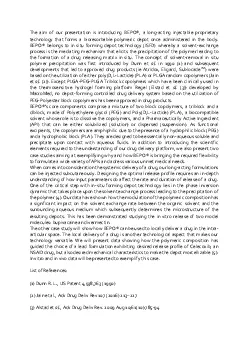

BEPOa longacting injectable proprietary technology that forms a bioresorbable polymeric depot once administered in the body BEPObelongs to in situ forming depot technology ISFD whereby a solventexc ID: 879537
Download Pdf The PPT/PDF document "The aim of our presentation is introduci..." is the property of its rightful owner. Permission is granted to download and print the materials on this web site for personal, non-commercial use only, and to display it on your personal computer provided you do not modify the materials and that you retain all copyright notices contained in the materials. By downloading content from our website, you accept the terms of this agreement.
1 The aim of our presentation is introduci
The aim of our presentation is introducing BEPO®, a long - acting injectable proprietary technology that forms a bioresorbable polymeric depot once administered in the body. BEPO® belongs to in situ forming depot technology (ISFD) whereby a solvent - exchange process is the mediating mechanism that elicit s the precipitation of the polymer leading to the formation of a drug releasing matrix in situ . The concept of solvent - removal in s itu polymer precipitation was first introduced by Dunn et al. in 1990 (1) and subsequent developments that led to approved drug products (ie Atridox, Eligard, S ublocade TM ) were based on the utilization of either poly(D,L - Lactide) (PLA) or PLGA random copol ymers (Jain et al . (2)) . Except PLGA - PEG - PLGA Triblock copolymers which have been clinically used in the thermosensitive hydrogel forming platform Regel (Elstad et al. (3)) developed by MacroMed, no depot - forming controlled drug delivery system based on th e utilization of PEG - Polyester block copolymers has been approved in drug products. BEPO® 's core components comprise a mixture of two block copolymers , a triblock and a diblock, made of Polyethylene glycol (PEG) and Poly(D,L - Lactid e ) (PLA), a biocompatib le solvent whose role is to dissolve the copolymers , and a Pharmaceutically A ctive Ingredient (API) that can be either solubilized (solution) or dispersed (suspension). As functional excipients, t he copolymers are amphiphilic due to the presence of a hydrophilic block (PEG) and a hydrophobic block (PLA). They are designed to be essentially non - aqueous soluble and precipitate upon contact with aqueous fluids . In addition to introducing the scientific elements req uired to the understanding of our drug delivery platform, we also present two case studies aiming at exemplifying why and how BEPO® is bringing the
2 required flexibility to formulate a wid
required flexibility to formulate a wide variety of APIs and adress various unmet medical needs. When comes into consideration the systemic delivery of a drug, our long - acting formulations can be injected subcutaneously. Designing the optimal release profile requires an in - depth understanding of how input parameters do affect the rate and duration of release of a drug. O ne of the critical step with in - situ forming depot technology lies in the phase inversion dynamic that takes place upon the solvent exchange process leading to the precipitation of the polymer (4) . Our data have shown how the modulation of the pol ymeric composition has a significant impact on the solvent exchange rate between the organic solvent and the surrounding aqueous medium which subsequently determines the microstructure of the resulting depot s . This has been demonstrated studying the in vit ro release of two model molecules: bupivacaine and ivermectin . The other case study will show how BEPO® can be used to locally deliver a drug in the intra - articular space. The local delivery of a drug is another technological aspect that makes our technolo gy versatile. We will present data showing how the polymeric composition has gu ided the choice of a lead formulation exhibiting desired release profile of Celecoxib, an NSAID drug, but also desired mechanical characteristics to make the depot morcellizable (5) . In vitro and in vivo data will be presented to exemplify this case . List of References: (1) Dunn R. L . , US Patent 4,938,763 (1990) (2) Jain et al., Adv Drug Deliv Rev 107 (2016) 213 â 227 (3) Alstad et al. , Adv Drug Deliv Rev. 2009 Aug 10;61(10):785 - 94 (4) Parent et al., J Control Release. 2013 Nov 28;172(1):292 - 304 (5) Hurtig et al., Osteoarthritis and Cartilage, April 2016 Volume 24, Supplement 1, Pages S524 â S52